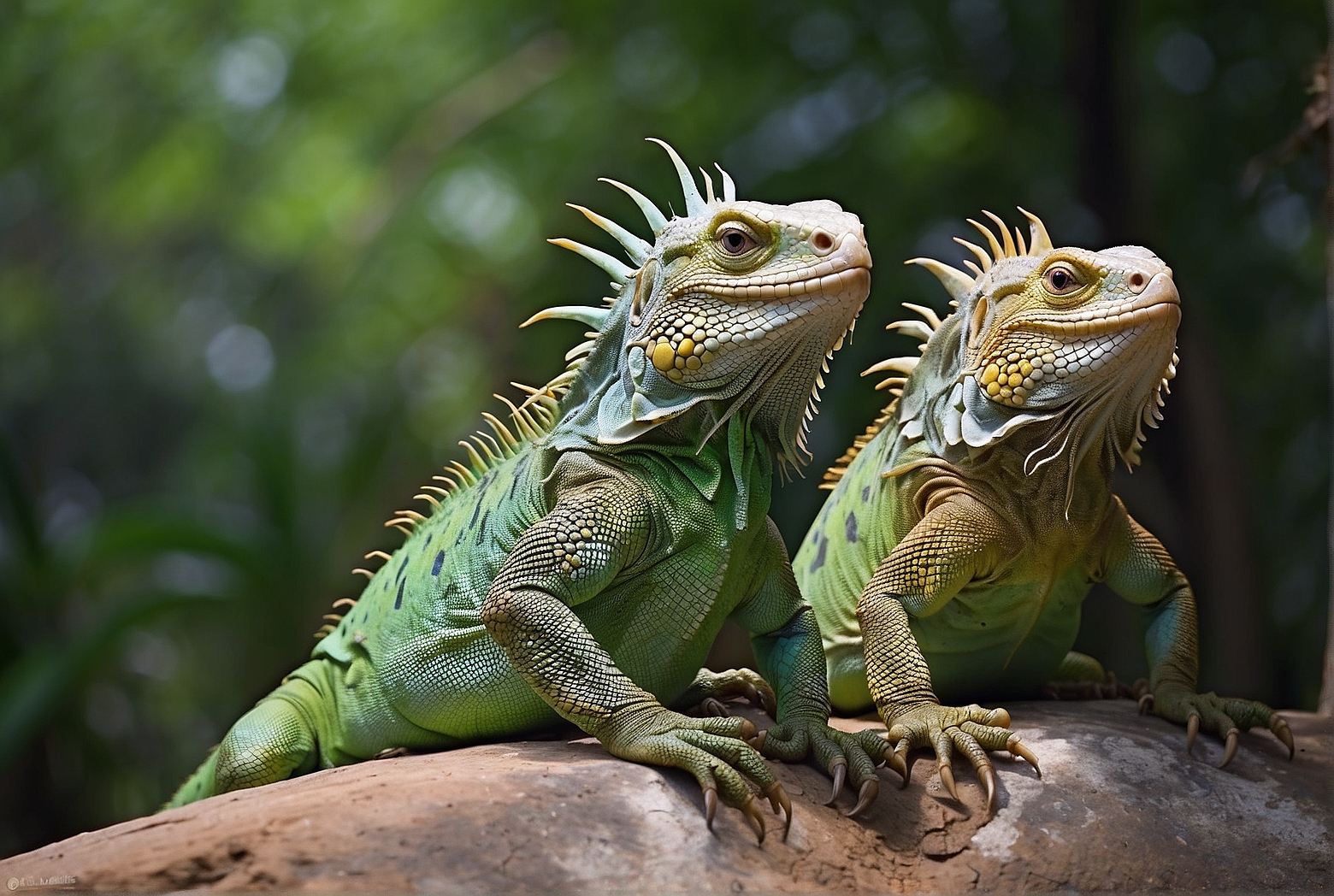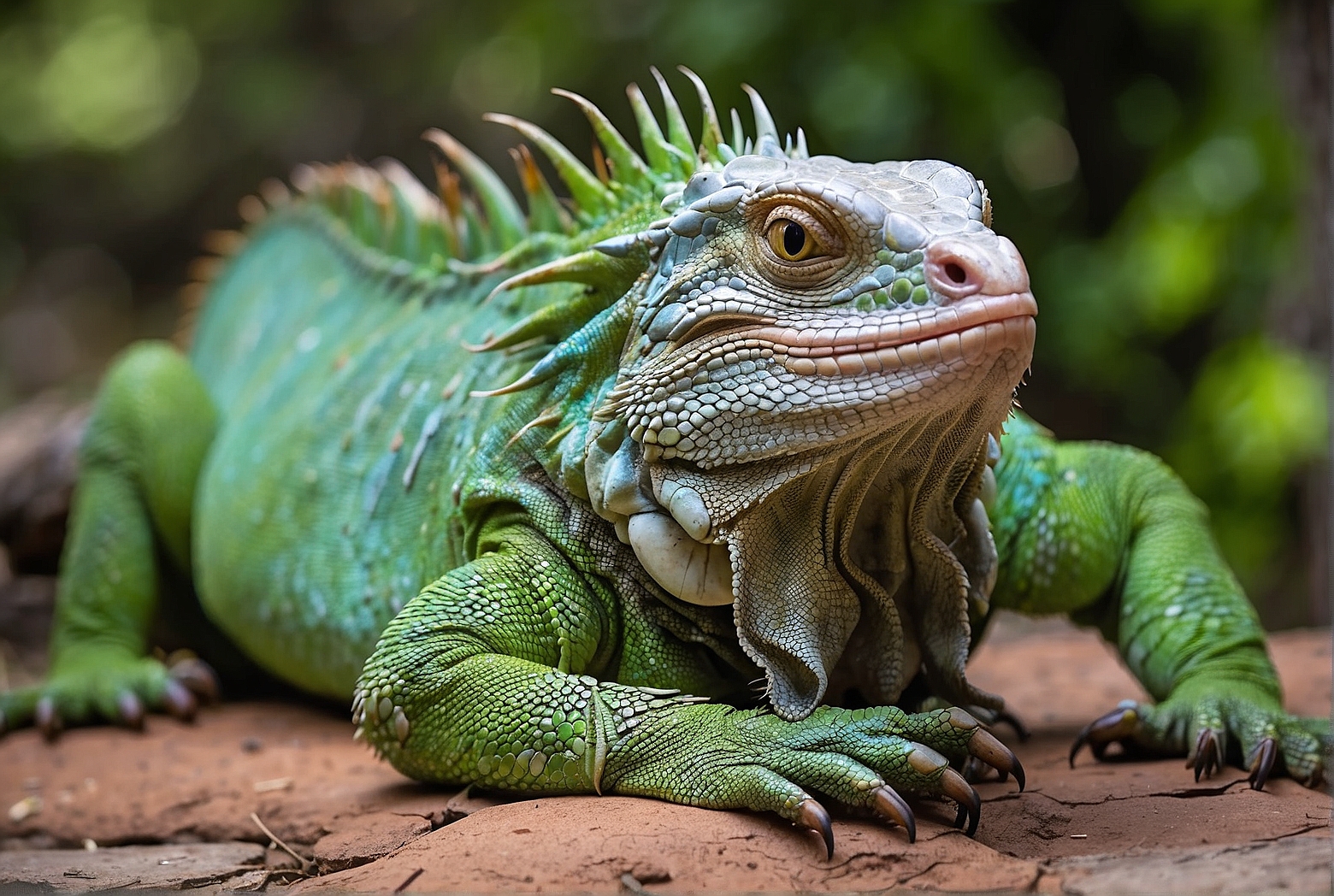Have you ever wondered how to distinguish between male and female green iguanas? Well, look no further! In this article, we will explore the key differences between these two remarkable creatures. From physical characteristics to unique behaviors, understanding the disparities between male and female green iguanas will not only deepen your knowledge of these captivating reptiles but also help you appreciate their remarkable diversity. So, let’s jump right in and discover the distinct features that set these magnificent creatures apart!
Physical Appearance
Size
The Green Iguana is known for its impressive size. As an adult, it can reach lengths of up to 6 feet, making it one of the largest lizard species in the world. The males, in particular, tend to be larger than the females, often measuring several inches longer and weighing more. While the males can grow to such substantial sizes, the females are no small creatures themselves, as they can still reach an impressive length of around 4 to 5 feet.
Color
Both male and female Green Iguanas display stunning, vibrant colors. The overall body coloration of these iguanas ranges from shades of bright green to a darker, almost turquoise green. However, the coloration can vary depending on the environment and individual. Additionally, male Green Iguanas tend to develop more pronounced coloration as they mature, with some individuals showcasing beautiful orange or yellow markings on their body.
Dewlaps
Dewlaps are important features that can be observed in both male and female Green Iguanas. A dewlap is a flap of loose skin located beneath the chin of these iguanas. However, it is more prominent and larger in males compared to females. Male Green Iguanas utilize their dewlaps to assert dominance and attract potential mates during the breeding season. When a male is trying to court a female or establish dominance over other males, he can extend and display his dewlap as a visual signal.
Behavior
Aggression
Green Iguanas generally have a calm and docile temperament, with both males and females exhibiting similar behavior. However, during the breeding season, males may become more aggressive towards each other as they compete for territory and mating opportunities. It’s important to note that while their aggression can be intimidating, they typically do not pose a threat to humans unless provoked or cornered. By giving them space and observing from a respectful distance, interactions with Green Iguanas can be peaceful and fascinating.
Territoriality
Territoriality is an inherent behavior observed in both male and female Green Iguanas. They establish and defend their territories, particularly during the breeding season. Males are more territorial than females, actively patrolling and defending their designated areas. They communicate their boundaries to other males through visual displays and physical confrontations. Females, on the other hand, may engage in territorial behaviors to safeguard their nesting sites or protect their young.

Communication
Green Iguanas communicate through a combination of visual displays and body language. Both males and females use head bobs, body postures, and dewlap extensions to convey messages to conspecifics. During courtship, males perform elaborate displays, such as head nodding, push-ups, and dewlap extensions, to attract females and exhibit their dominance. Females may respond to these displays with their own signals, expressing their interest or disinterest in potential mates. Communication among Green Iguanas is both complex and intriguing, reflecting their social interaction and reproductive behaviors.
Reproduction
Mating Behavior
The mating behavior of Green Iguanas is fascinating to observe. During the breeding season, which often occurs in the warmer months, males actively search for receptive females to mate with. They compete for these females by displaying their physical attributes, performing intricate courtship displays, and engaging in physical combat with rival males. These displays and competitions are not only a means to attract females but also to establish a hierarchy within their population.
Egg Laying
After successful mating, female Green Iguanas undergo a process known as oviposition. They carefully select suitable nesting sites, typically in sandy or loose soil, where they dig burrows to lay their eggs. The females create significant excavations, laying clutches of eggs that can range from 20 to 70 in number. After carefully burying the eggs, the females leave them to incubate naturally. The incubation period lasts around two to three months, depending on environmental conditions such as temperature.
Parental Care
Green Iguanas do not exhibit parental care beyond the egg-laying stage. Once the female has completed the process of burying the eggs, her involvement in their development ceases. The eggs are left to incubate and hatch without any assistance from the parents. After hatching, the newborn iguanas, known as hatchlings, are fully independent and begin their journey in the world without any parental guidance.
Diet
Herbivorous Diet
Green Iguanas are herbivores, meaning they primarily consume plant matter. Their diet consists mainly of leaves, fruits, flowers, and even some vegetables. They possess specialized teeth that allow them to efficiently grind and chew plant material. It is important to provide a well-balanced diet for captive Green Iguanas, including a variety of leafy greens, vegetables, and occasional fruits. Proper nutrition is crucial for their overall health and vitality.
Food Preferences
While Green Iguanas have a general herbivorous diet, they do exhibit preferences for specific types of plants. Some favorites among these iguanas include hibiscus flowers, dandelion greens, and various types of fruits and vegetables. However, it’s essential to ensure that their diet is diverse and nutritionally balanced. Offering a wide variety of plants not only stimulates their appetite but also provides the necessary nutrients for their well-being.

Habitat
Natural Range
Green Iguanas are native to the tropical regions of Central and South America, inhabiting countries such as Mexico, Belize, Costa Rica, and Brazil. Within these regions, they can be found in a wide range of habitats, including forests, rainforests, coastal regions, and even urban areas. They are well-adapted to these diverse environments and can thrive in various climatic conditions.
Preferred Environments
Green Iguanas are arboreal lizards, meaning they are well-suited for life in trees. They are most commonly found in tropical forests near streams or rivers, as the availability of water is crucial for their survival. These iguanas require high humidity levels and rely on a combination of sunlight and shade to regulate their body temperature. In captivity, it is crucial to replicate these environmental conditions to ensure the well-being of these amazing creatures.
Lifespan
Longevity
The lifespan of Green Iguanas can vary depending on various factors such as diet, habitat, and overall care. On average, Green Iguanas can live anywhere from 10 to 15 years in the wild. However, with proper care and optimal conditions, they can live well into their 20s or even 30s. Providing a balanced diet, appropriate enclosure, and regular veterinary check-ups can greatly contribute to their longevity.
Factors Affecting Lifespan
Several factors can influence the lifespan of Green Iguanas. One crucial aspect is their diet, as a poor or imbalanced diet can lead to health issues and shortened lifespans. Additionally, the quality of their habitat, including temperature, humidity, and access to UVB lighting, plays a vital role in their overall health and longevity. Regular veterinary care, proper hygiene, and a stress-free environment are also important in ensuring a healthy and extended lifespan for these captivating reptiles.
Sexual Dimorphism
Physical Differences
Sexual dimorphism refers to the physical differences between males and females of a species. In the case of Green Iguanas, there are noticeable variations between the two sexes. Male Green Iguanas tend to be larger and heavier than females, with more robust bodies and longer tails. Females, although slightly smaller, still display a formidable size and possess slimmer bodies compared to their male counterparts.
Secondary Sexual Characteristics
Aside from size differences, male and female Green Iguanas also exhibit distinct secondary sexual characteristics. Males develop large, prominent dewlaps that they can extend and display during courtship rituals. In contrast, females typically have smaller, less pronounced dewlaps. These dewlaps play an essential role in signaling dominance and attracting potential mates, making them an unmistakable feature of male Green Iguanas.
Social Structure
Hierarchy
Green Iguanas establish a hierarchical social structure within their population. Males compete for dominance and mating rights, with the larger and more dominant individuals occupying the highest positions in the hierarchy. The establishment of this hierarchy is often achieved through displays of physical aggression and rituals such as head bobbing. This social structure ensures order and minimizes unnecessary physical confrontations within their population.
Group Behavior
While Green Iguanas are not inherently social creatures, they exhibit certain group behaviors, particularly during the breeding season. Breeding aggregations, where both males and females gather in large numbers, can be observed in certain areas. However, these gatherings are temporary and more likely driven by the availability of resources, such as suitable nesting sites. Outside of the breeding season, Green Iguanas are usually solitary creatures, though they may tolerate others’ presence in their territories.
Thermoregulation
Basking Behavior
Green Iguanas rely on basking behavior to regulate their body temperature effectively. They require access to ample sunlight and heat to raise their body temperatures, allowing for optimal physiological functioning. These iguanas are often observed perched on branches or rocks, with their bodies exposed to direct sunlight. Basking behavior is crucial for their digestion, metabolism, and overall well-being.
Heat Sensing
Green Iguanas possess an ability known as thermoreception, allowing them to sense and navigate temperature variations in their environment. They can detect heat sources and actively seek out areas with appropriate temperatures for thermoregulation. This ability is necessary for their survival and enables them to make informed decisions on where to position themselves to maintain their body temperature within an optimal range.
Predators and Defense Mechanisms
Threats
Green Iguanas face various threats and predators in their natural habitat. Some of the notable threats include birds of prey, such as hawks and eagles, that can swoop down and capture them. Additionally, large snakes, such as boa constrictors and anacondas, pose a significant danger to both juvenile and adult Green Iguanas. Other terrestrial predators, including mammals like raccoons and feral cats, may also prey upon these iguanas if given the opportunity.
Defense Strategies
When faced with potential threats, Green Iguanas employ a range of defense strategies to protect themselves. Their primary defense mechanism is their incredible agility and climbing skills. When confronted, they can quickly escape predators by scaling trees or diving into bodies of water. Additionally, they can also rely on their powerful tail to deliver swift strikes against an aggressor. While they may avoid physical confrontations if possible, these defense strategies can prove effective in ensuring their survival.
In conclusion, the Green Iguana, with its impressive physical appearance and fascinating behavior, is truly a remarkable reptile. From its size and coloration to its territoriality and communication methods, this species showcases a wide range of intriguing characteristics. While males and females may exhibit some differences, both play important roles in the social hierarchy and reproductive processes. With proper care, a balanced diet, and suitable habitat conditions, these captivating creatures can thrive and live long, fulfilling lives.
